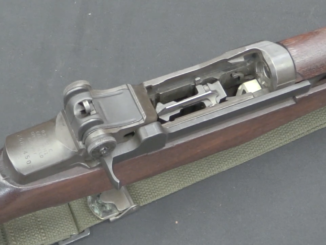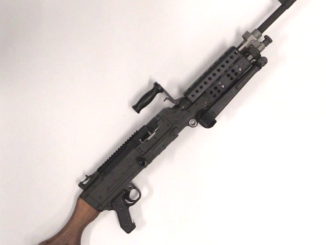This is Lot 1037 in the upcoming October 2019 Morphy Extraordinary auction.
The United States went into World War Two with the Thompsons submachine gun – a weapon far too heavy and too expensive for its role. The British went to the other extreme with the Sten and while the US did not want a gun quite that crude, the Sten did spur a desire for something cheaper than the Thompson. George Hyde (the working for the Inland Division of GM) had worked on submachine gun designs in the 1930s, and he put together a weapon that would fit US needs. It was much cheaper than the Thompson and weighed in a full 2 pounds lighter. At tests in the spring of 1942, it also proved to be much more accurate in automatic firing, as it had a much more ergonomic stock design than the Thompson. The weapons was approved as the M2 submachine gun in 1942, and a contract went to Marlin to produce it (Inland had no extra production capacity at the time).
The receiver of the M2 was made through a metal sintering process, and Marlin had trouble getting this properly tooled up. The first gun delivery didn’t actually happen. Until May or 1943, and by that time Hype had finished designing the M3 “Grease Gun”, which was cheaper still, and more attractive to the military. The contract for the M2 was cancelled in June of 1943, with only 400 guns delivered. There are only six known surviving examples today, split between private collections, museums, and military institutions.




Now we see why the M3 was chosen instead: it was probably easier and cheaper to get stamping presses! Could the M2 be made with a stamped receiver? If so, would it be worth the investment?
M3 (Grease Gun) was also different in that it has retractable stock, making it much more suitable, for anyone who do not use small-arm as main, that is artillerymen, crews of armoured vehicles and so on.
But Grease Gun also (like many guns of its era) used a rear-seared trigger group, moving the trigger ~6″ farther back than it could have been, for no real gain.
At least, by using a shorter / fatter bolt, it wasn’t as bad in that regard as some contemporaries (MP40, etc.).
“(…)stamped(…)”
During wartime Hyde designed also MG42-inspired .30 Carbine-cartridge firing sub-machine gun with quick-change barrel, see photos: https://www.smallarmsreview.com/display.article.cfm?idarticles=2550
Whyabouts of its creation remain unknown. I am wondering how does it compare manufacturing-complexity-wise with following weapons: M2 Carbine, M2 Hyde, M3 Grease Gun
Outstanding weapon….wish I could afford one 🙂
Could Tommy gun be made from stamped receiver ? Also, why for the love of God, nobody ever redesigned its awkward armpit stock, it would be easy to do as it is removable part.
Had he used a full-profile bolt (milled for clearance on the bottom, feed-lip area only) like most other SMGs, he could have:
-Used a simple trunnion-in-tube receiver (no stamping presses required!)
-Dispensed with the complex sintered forward receiver that shut down production
-Preserved more of the bolt’s mass for the same length, allowing a smaller overall bolt diameter and obviating the need for the extra-fat receiver
“Good Idea Fairy” strikes again!
Sorry, this was in response to Cherndog’s post, but moved down the list while awaiting moderation.
Ian really needs to get this moderation thing checked. Thanks for the response, Mike! So if you’re right, we wouldn’t need much more machine operations for the same M2 if the design were simplified to that extent.
His e-mail regarding this issue was a very professional and gracious touch.
400 made, only 6 survive, what happened to the others, are they “lost” or government destroyed ?
Small Arms Review has article describing mainly result of tests of this weapon.
https://www.smallarmsreview.com/display.article.cfm?idarticles=2609
“(…)At tests in the spring of 1942, it also proved to be much more accurate in automatic firing, as it had a much more ergonomic stock design than the Thompson.(…)”
Interestingly it evolved from Hyde Model 109 which has layout much more akin to Thompson (forward grip, cooling fins). M2 Hyde also fired less frequently than Thompson: 527 rpm vs 610 rpm of M1928A1 vs 775 rpm M1 – although this is around 86% of earlier Thompson it might have bigger impact than linear, as according to page 68 of http://www.quarryhs.co.uk/Emeric2019.pdf
it was discovered that due to muscular response, the lowest dispersion would be achieved for a firing frequency lower than 10Hz (600rpm) or higher than 20Hz (1200rpm), the highest dispersion of a hand-held rifle would be achieved with a firing frequency between 14Hz (840rpm) and 18Hz (1080rpm)
Naturally there is also question about how “brutally” moving parts stop at extreme position. Anyway independently from de facto reason, M2 Hyde was judged high by tester in that regard.
It was also found less malfunction-prone than Thompson sub-machine gun:
the Hyde-Inland weapon was superior to the M1 Thompson from a five- percent reduction in weight to a ninety- percent reduction in malfunctions. Accuracy in full-automatic fire was nearly perfect. All of the features of light weight, accuracy, absence of malfunctions, simplicity of construction, combined to make the proposed M2 far superior than any other weapon previously presented to the Ordnance Department.
“The weapons was approved as the M2 submachine gun in 1942”
And declared(…)obsolete on 14 June 1943, making it probably one of sub-machine gun with shortest time between adoption and being declared obsolete.
“(…)Thompsons submachine gun – a weapon far too heavy(…)”
There was also another attempt to make it lighter by wide usage of Aluminum, see photos: https://www.smallarmsreview.com/display.article.cfm?idarticles=1971
but it eventually proved unsuccessful.
If they wanted a higher mass bolt to fire .45 acp why didn’t they just make a hollow conventional diameter bolt and fill it with lead instead of the ridiculously big diameter they went to ?
It also seems logical to me to have just redesigned the Thompson to be stamped or made from tube, and keep a weapon everyone was familiar with, just make it cheaper ?
Maybe the Thompson company would have never allowed its patents to be used even in wartime ?
An interesting design – but perhaps ‘too’ original (it often a mistake to do lots of new things at the same time). However given that and beyond what you have already said. How did it compare to its contemporaries (including comparative cost)?
Interesting about that nested recoil spring setup.
In 1980, Lueder Seecamp patented (US4201113A) a very similar setup, specifically for use in automatic pistols, and he received royalties through the ’80s and ’90s from quite a few manufacturers of compact and subcompact pistols.
(This patent is why the first three generations of Glocks, designed during the term of Seecamp’s patent, used single recoil springs for all but the subcompact models to avoid royalties; only in the 4th generation, after the patent expired, they applied the nested spring assembly to all models.)
I wonder if this gun, had it not been a forgotten weapon by then, might have been used to invalidate Seecamp’s patent.
Patent on this gun exists, but I did not study it enough (yet) to see if it covers the spring, most likely not, as its spring has no fancy space saving buffering intent,
so it is not connected or predating to Seecamp.
As for the poor old Glock, glad they got burned with that patent, as they are screwing the industry in last 30 years (and next 30??) with their copyrighted squareish slide, did you ever wondered why EVERY other similar modern handgun (like XD) has slide serrations on the front (and Glock obviously does not)?
Of course its not what they tell (in fact lie) “for easier front slide racking”. Go figure…
“its spring has no fancy space saving buffering intent”
I’m not sure what intent you think it has then, as space-saving (whether that takes the form of more travel in the same space, or the same travel in less space) and buffering are exactly the two things it offers over a conventional single spring. The patent (US2548622A) does describe the spring arrangement and particularly notes the buffering effect, but no mention is made of space-saving. (The spring arrangement is not mentioned in the claims, which pertain to the fire control group.)
“not connected to or predating to Seecamp”
It unquestionably predates Seecamp’s patent; as I said, that was from 1980, some decades later.
Whether it is sufficiently connected to make Seecamp’s claimed invention obvious, that’s a good question. Seeing as it appears to be providing the same benefits in a different platform, the step of applying it to a handgun rather than an SMG seems obvious, but I’m not sure of that. A lot would probably have depended on what documentation could have been found to establish that Hyde (or anyone else in the industry) was already aware of the arrangement’s benefit in compactness for a given working stroke, since that benefit is not elaborated in US2548622A.
As for Glock, that was just the example I expected people were most likely to be more-or-less aware of; other makers have also made similar transitions, and new designs can be expected to continue making more use of the nested-spring arrangement.
The point is not to pity (or rejoice about) one company, it’s that an entire industry was held back, only applying the nested-spring “innovation” where the benefits were sufficient to justify royalties (basically, only in subcompacts and pocket pistols), and not using it in other applications where it would still be beneficial, but less so.
Now this process of holding some aspect of an entire industry hostage for a few years to enrich the inventor is exactly how the patent system is meant to work; that’s how we reward original invention. And that’s fine as long as the invention is really novel, but to the extent that the invention isn’t novel, it becomes a tragedy. The classic example in the firearms world is the Rollin White patent that S&W used to lock down the cartridge revolver market in the US, despite the bored-through cylinder being previously invented by Lefaucheux.
Even assuming that the Seecamp patent should actually have been invalidated by Hyde’s recoil spring arrangement (and again, I’m not sure of this), it’s undoubtedly had a far smaller effect on the industry than the Rollin White patent. But it’s no less a tragedy for its smaller scale.
Funny how the front end looks like a Mini-14.
Some probably ended up in Germany after the war when police forces were set up again; the Bundeswehr/federal police designation is apparently MP52 (the MP51 being the Thompson M1A1).
From the Record of Developmental and Experimental Ordnance Vol. 17, The Sub-Machine Gun (Wash. D.C.: Office of the Chief of Ordnance, Research and Development Service, n.d.), IF8
“[After testing the Hyde 109 prototype], It was redesigned and a new gun, identified here as the Hyde-Inland I [prototype M2], was submitted to Aberdeen and tested on 2, 9, 10, 15 April 1942. All of the objectionable characteristics of the pilot model of the series Hyde 109, had been eliminated. The action had been completely enclosed and there were no external moving parts to disturb the operator or to catch in his clothing. Barrel-fins had been removed and the stock extended to enclose the barrel and protect the operator’s hand. The straight blowback action was the same and the weapon was capable of either semi-or full-automatic fire, controlled by a selector. Bolt and firing pin were a unit. the gun was lighter than both the Hyde 109 and Thompson M1928A!.
ACCURACY–The gun was tested in competition with the Thompson M1928A! and M1. Ten shots were fired from a machine rest, full-automatic fire, on each of three targets at a range of 100 yards. The composite figures for the 30 rounds were:
Hyde-Inland I … 8.68″ EHD 9.53″ EVD 11.06″ ES
Thompson M1928A! 9.68″ EHD 10.24″ EVD 10.94″ ES
Thompson M1 … 6.38″ EHD 11.57″ EVD 9.20″ ES
The test was repeated with the selectors set for semi-automatic fire. The three guns performed as follows:
Hyde-Inland I … 6.90″ EHD 8.20″ EVD 9.20″ ES
Thompson M1928A1 6.28″ EHD 9.71″ EVD 10.57″ ES
Thompson M1 …. 6.63″ EHD 8.20″ EVD 9.40″ ES
At a range of 50 yards in full-automatic fire from the offhand position, the Hyde-Inland I placed 99 of 100 shots upon the 6’x6′ target. This compared with 50 hits for the M1 and 49 for the M1928A1. Those who fired the subject gun stated that it handled very well, that the recoil was soft, and that there was no appreciable tendency to climb under full-automatic fire.
One hundred rounds (ten targets) were fired off-hand, semi-automatic, at a range of 50 yards. The following averages were recorded:
Hyde-Inland I … 19.07″ EHD 28.87″ EVD 31.76″ ES
Thompson M1928A! 9.82″ EHD 10.24″ EVD 12.36″ ES
(average of 5 targets)
Thompson M1 … 13.72″ EHD 18.77″ EVD 21.01” ES
The subject gun was fired 6,080 rounds in the endurance tests. There were 20 malfunctions, 15 being failures of the bolt to remain open after the last round was fired. On three occasions the bolt remained open but closed when the magazine was withdrawn. The other malfunctions were one light firing-pin blow and one failure to feed.
The average cyclic rate was 527 rounds per minute. That of the Thompson M1928A1 was 610; that of the M1 was 775.
DUST TEST–Thirty rounds fired without malfunctions after the gun was subjected to the standard dust test. Only a negligible amount of dust was found to have penetrated the mechanism.
MUD TEST–The gun failed to function after immersion in thin mud. The mechanism was well filled with mud and the operating handle spring lock broke when an attempt was made to manipulate it. The broken piece jammed the bolt in the retracted position.
It may be mentioned that the Hyde-Inland I functioned very well in firing the cal. .45 tracer ammunition from the 30-round magazine supplied by the manufacturer. A total of 520 rounds was fired with only four failures to feed due to a faulty magazine. The cyclic rate with the lighter ammunition was 440 rounds per minute.
The conclusions reached wre that the Hyde-Inland I was superior in accuracy to the M1 and M1928A1 in full-automatic fire from a machine rest but that it was poor in comparison with the control weapons in offhand semi-automatic fire. In full-automatic fire, off-hand, it was superior to the control weapons or to any submachine gun submitted.
Service tests appeared warranted but the designer wished to make certain minor modifications and then resubmit the arm.
HYDE-INLAND–Five guns–here identified under the heading Hyde-Inland 2– were submitted by the maker and tested 19,21,22 June 1942. They embodied minor modifications of the Hyde-Inland I and were fired only for functioning. A total of 2,540 rounds was fired and only two serious malfunctions recorded.
Recommendation was made that the magazine well be deepened so as to accommodate satisfactorily the optional 30-round magazine and that a heavier operating spring be used.
In full-automatic fire the gun jarred noticeably, indicating that the bolt was striking the buffer and lacked energy in the closing stroke.
Subject to those improvements being made the Hyde-Inland gun was recommended for standardization as the Submachine Gun, M2, but oRdnance Committee action classified the arm as Substitute Standard (30 April 1942). In view of the tremendous requirements for submachine guns at that time it was not considered advisable to convert existing facilities to the manufacture of the new weapon and an attempt was made to produce the M2 by awarding contracts to firms not then engaged in war work. Many difficulties were encountered, as was anticipated, and actual production models of the M2 did not reach Aberdeen until May, 1943, five months after the M3 had been standardized. Production of the M2 was discontinued.
During the period which covered the modification of the Thompson guns and the adoption of the M2 as a Stubstitute Standard item, more than twenty submachine guns of American and foreign manufacture were tested at Aberdeen Proving Ground. Those weapons and their performances under test are reported in the second section of this article… “